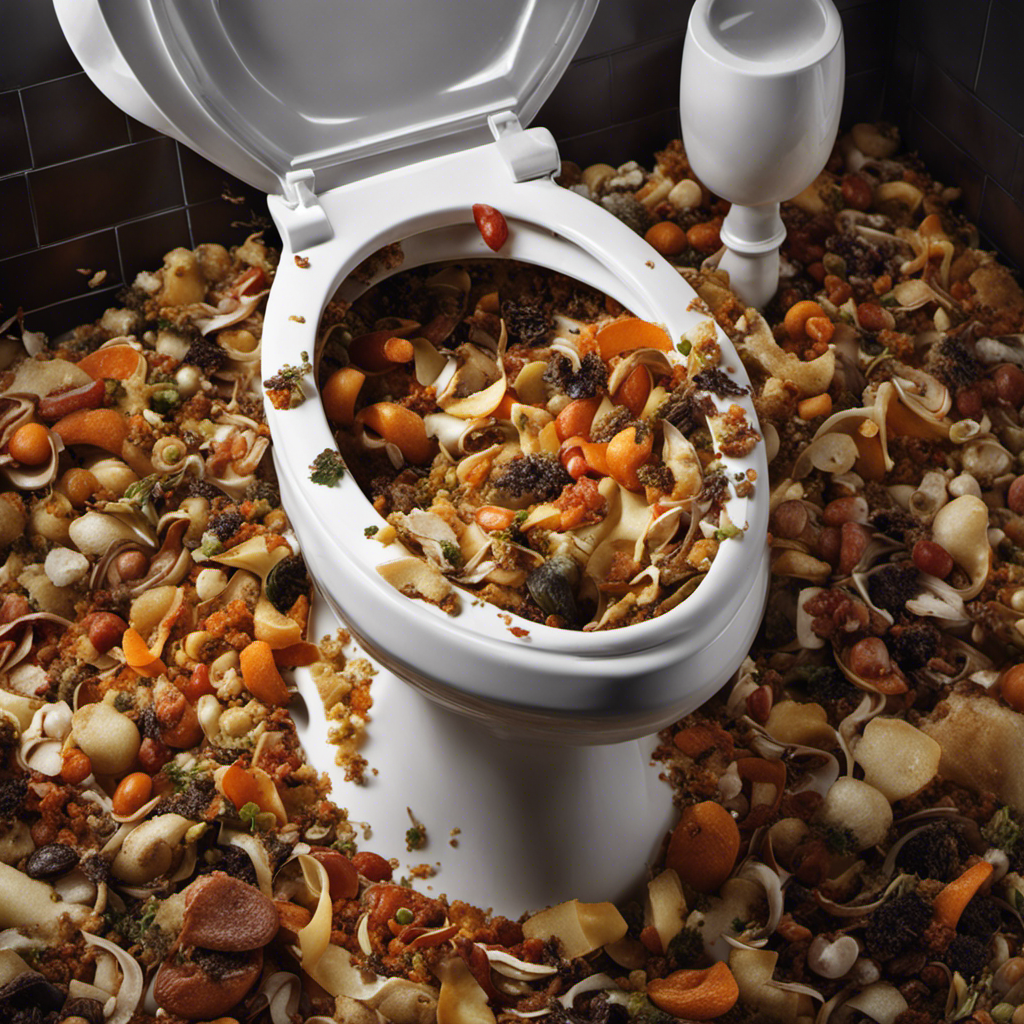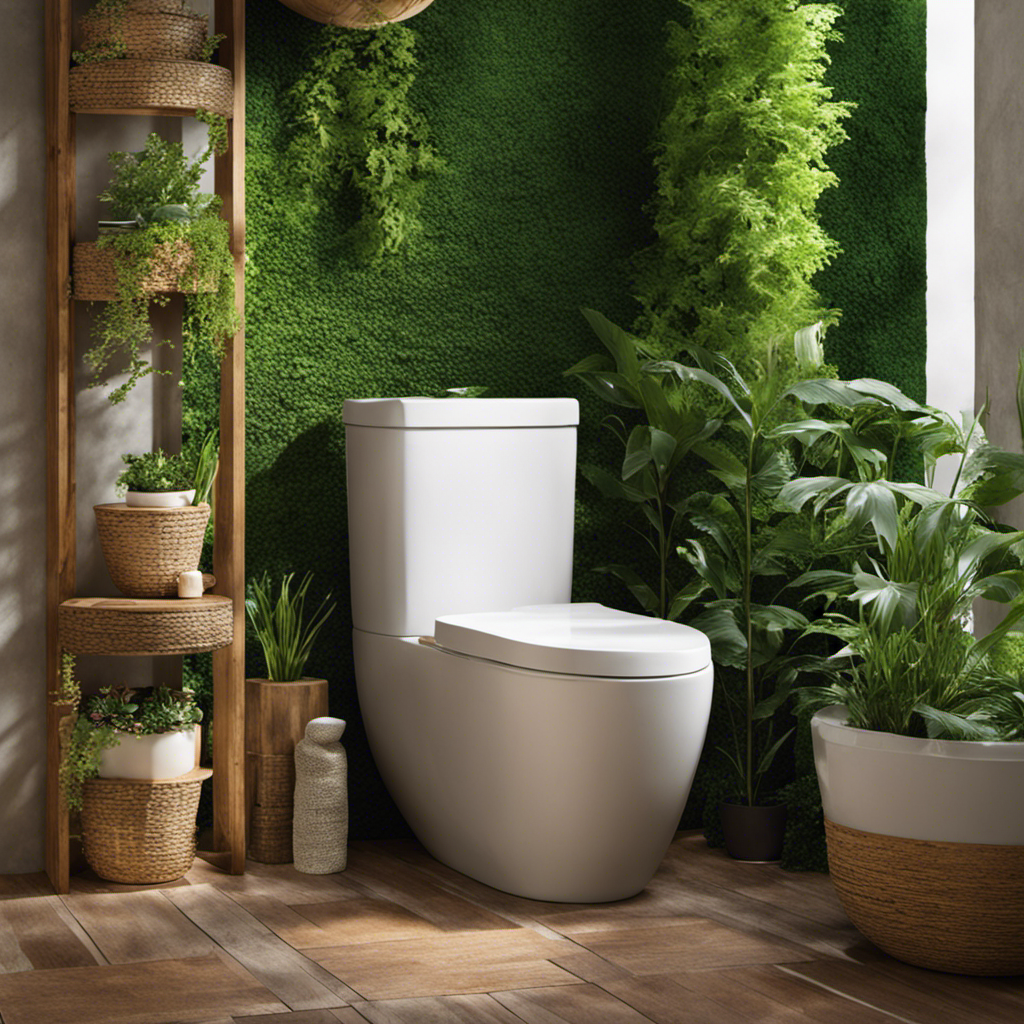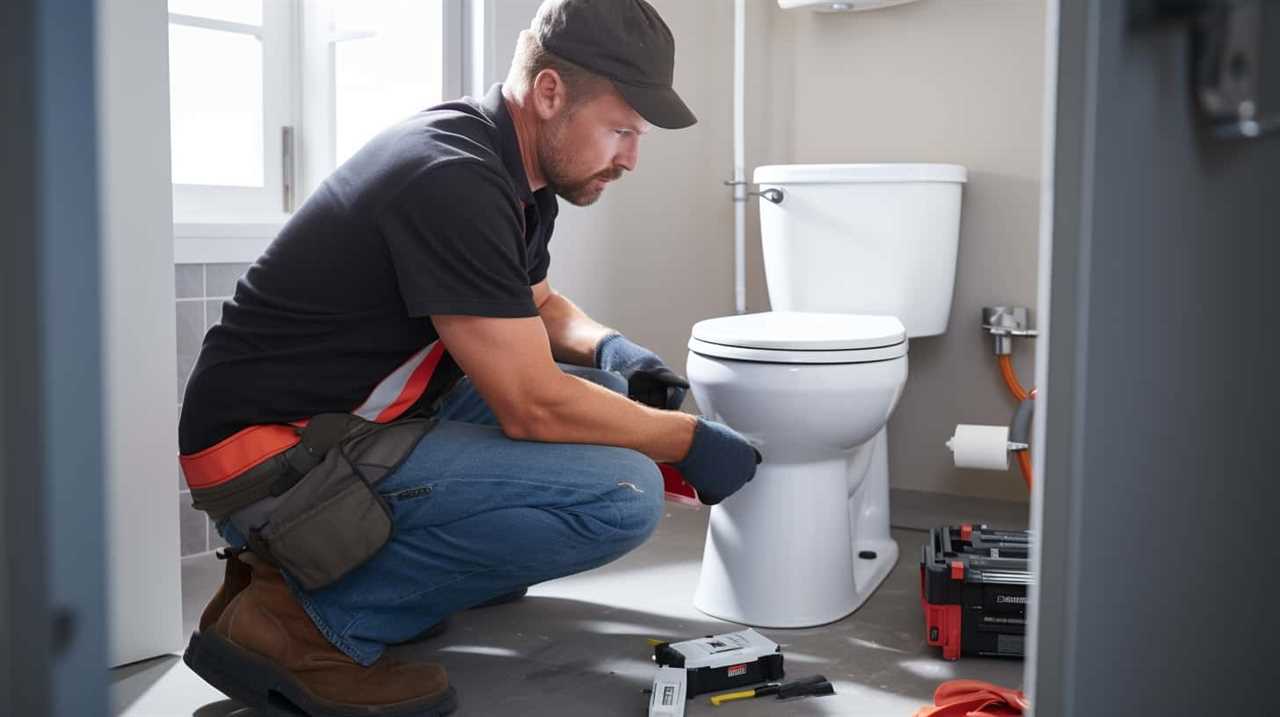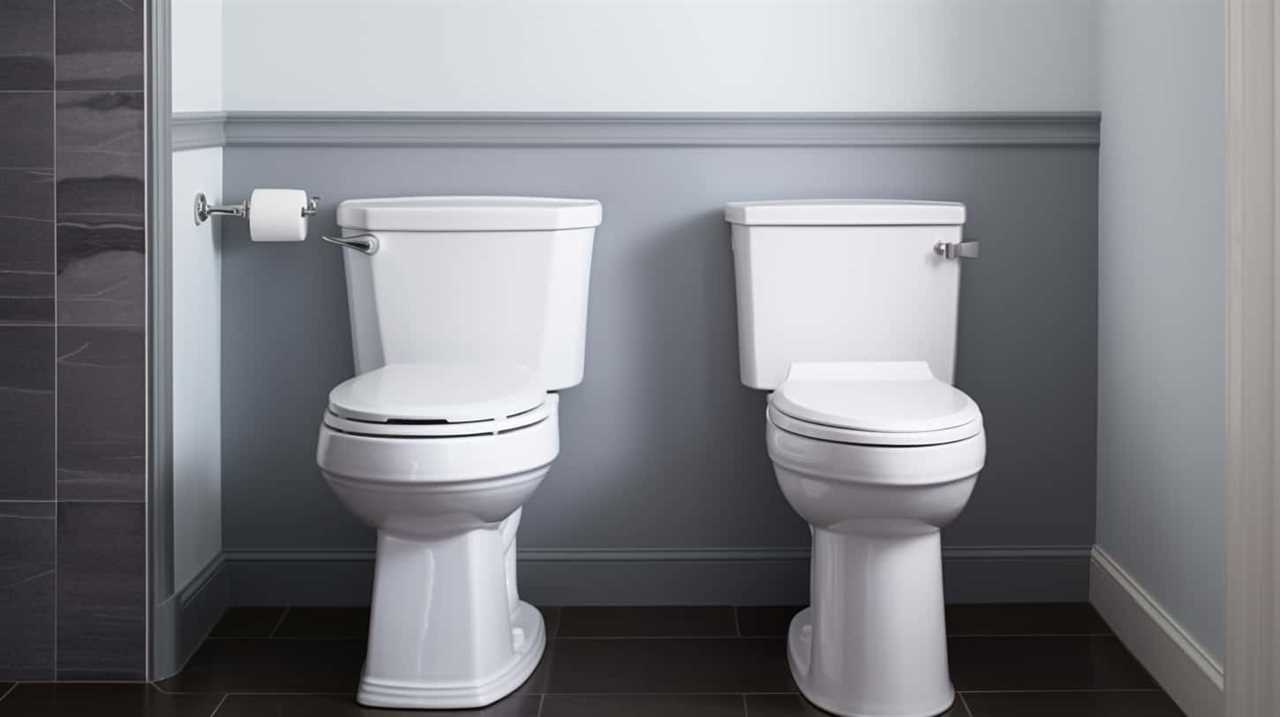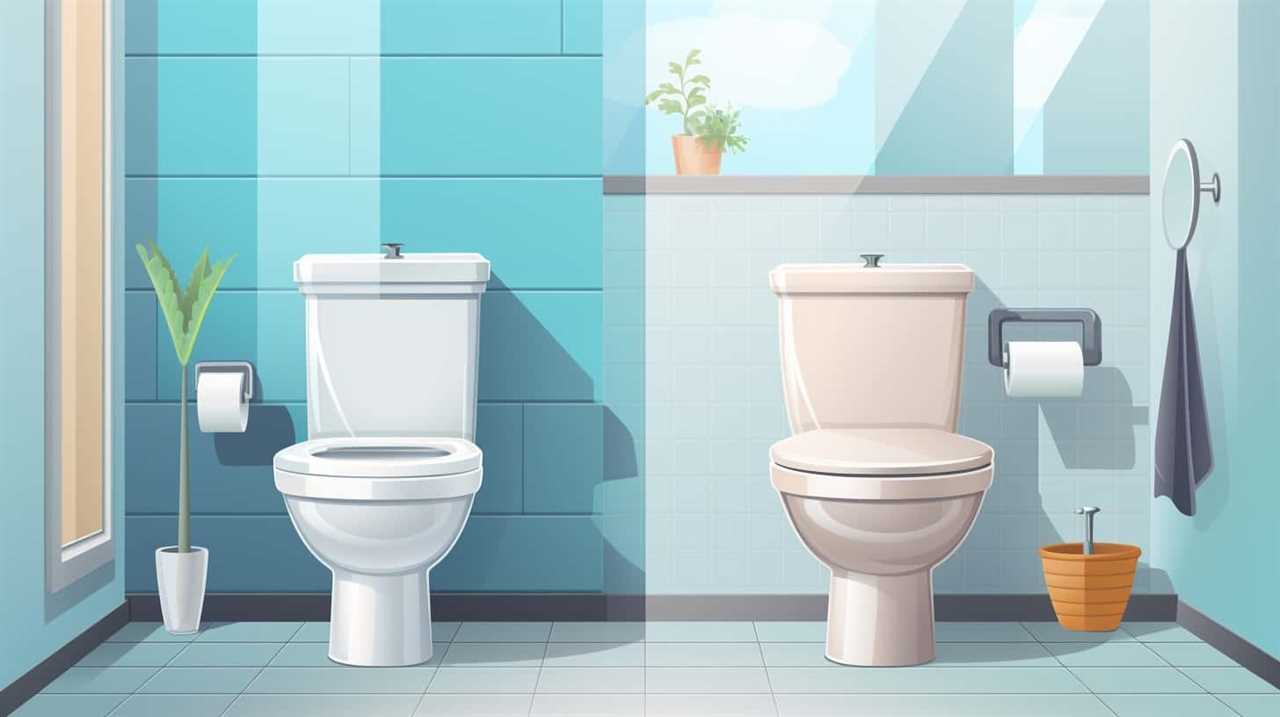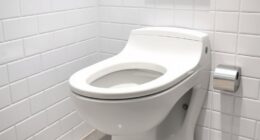As I stood in my bathroom, faced with a clogged toilet and a nauseating odor, I couldn’t help but wonder how I had ended up in this messy situation. Flushing food down the toilet seemed like a convenient solution at the time, but little did I know the havoc it would wreak on my plumbing.
In this article, I will shed light on the reasons why flushing food can lead to clogs and odor, the types of food that are notorious culprits, alternative methods for disposing of food waste, and solutions for unclogging food-induced toilet clogs.
It’s time to say no to flushing food and save ourselves from the headaches and inconvenience it brings.
Key Takeaways
- Flushing food down the toilet can lead to clogged pipes, bad odor, and water leaks.
- Certain types of food, such as greasy, starchy, and hard food scraps, are more likely to cause clogs.
- There are alternative disposal methods for food waste, such as saving leftovers, throwing them in the garbage bin, feeding pets, or composting.
- If a toilet is clogged due to food waste, using a plunger or toilet auger can be effective solutions before contacting a professional plumber.
Reasons Why Flushing Food Can Lead to Clogs and Odor
Flushing food down the toilet can lead to clogs and odor because food scraps are too large for the sewer system pipes and can accumulate, causing blockages. This can result in some cautionary tales and health risks.
When food waste is flushed, it doesn’t degrade easily and can build up in the pipes over time. Most types of food are highly absorbable, making it difficult for waste to pass through. Accumulated food waste can form clogs large enough to disable the toilet, leading to water leaks and bad odor.
Not only does this pose a risk to the plumbing system, but it can also create unsanitary conditions in the bathroom. Therefore, it’s important to avoid flushing food down the toilet to prevent these issues and maintain a healthy environment.
Types of Food That Can Cause Toilet Clogs
I’ve learned that certain types of food, like greasy and oily items, starchy dishes, grains, hard scraps, and even soup, can all contribute to clogs in the toilet. To prevent clogs caused by food waste, it is important to avoid making common mistakes when disposing of food waste.
Here are four types of food that can cause toilet clogs:
-
Greasy and oily food: Meat and other greasy items can create sticky clogs in the sewer system.
-
Starchy food: Mashed potatoes and other starchy dishes can become gelatinous and obstruct water flow.
-
Grains: Rice, in particular, expands quickly when flushed and can form clogs.
-
Hard food scraps: Bones and shells don’t break down and can’t fit through narrow pipes.
Alternative Methods for Disposing of Food Waste
When it comes to disposing of food waste, there are several alternative methods that can be considered.
One of the most beneficial methods is composting. Composting food waste has numerous benefits and helps reduce the impact of food waste on the environment.
By composting, organic materials such as fruit and vegetable scraps, coffee grounds, and eggshells can be turned into nutrient-rich soil. This soil can then be used to nourish plants and gardens, reducing the need for chemical fertilizers.
Additionally, composting helps divert food waste from landfills, where it would release harmful greenhouse gases. By choosing to compost, we can make a positive impact on the environment and contribute to the cycle of natural resource renewal.
Solutions for Unclogging Food-Induced Toilet Clogs
Using a plunger or a toilet auger can be effective solutions for unclogging toilet traps caused by food waste. Here are some common mistakes to avoid when attempting to unclog a toilet:
-
Neglecting to use a plunger or toilet auger: These tools are designed to apply pressure and break through clogs, making them essential for effective unclogging.
-
Using improper techniques: It’s important to use the correct plunging technique, with a tight seal and vigorous up-and-down motions. For toilet augers, make sure to insert the auger into the trap and rotate it gently to break up the clog.
-
Ignoring multiple flushes: After successfully unclogging the toilet, it is crucial to flush it multiple times to ensure proper functioning and remove any remaining debris.
-
Failing to seek professional help: If plunging and augering do not resolve the issue, it is advisable to contact a professional plumber to avoid further damage to the plumbing system.
Factors That Affect the Self-Unclogging of a Toilet
Toilet clogs caused by food waste can vary in their ability to unclog themselves depending on factors like the size and type of food waste. Factors such as water pressure and toilet design can also play a role in the self-unclogging process.
Table: Factors Affecting Self-Unclogging of a Toilet
| Factors | Role |
|---|---|
| Water Pressure | Higher water pressure can help in dislodging and breaking down clogs. |
| Toilet Design | The shape and size of the toilet trap can affect the flow of waste. |
| Food Waste Size | Larger food waste particles may require more intervention to unclog. |
| Food Waste Type | The consistency and absorbability of food waste can impact unclogging. |
Water pressure plays a significant role in the self-unclogging process. Higher water pressure can help dislodge and break down clogs more effectively. Additionally, the design of the toilet, particularly the shape and size of the toilet trap, can affect the flow of waste and potentially hinder self-unclogging. Furthermore, the size and type of food waste can impact the ability of the toilet to unclog itself. Larger food waste particles may require more intervention, while the consistency and absorbability of the food waste can also influence self-unclogging.
Conclusion: the Importance of Saying No to Flushing Food
I’ve learned that it’s crucial to refrain from flushing food down the toilet due to the potential clogging, bad odor, and water leaks it can cause. Flushing food waste not only poses a risk to the proper functioning of the sewer system, but it also has significant environmental impacts.
Here’s why proper food waste disposal is important:
-
Prevents clogs: Food scraps are too large for sewer system pipes and can accumulate, leading to clogs that can disable the toilet.
-
Reduces bad odor: Food waste doesn’t degrade easily and can produce unpleasant smells, especially when trapped in the pipes.
-
Minimizes water leaks: Flushing food can clog toilet traps, causing water leaks that can damage your bathroom and waste water.
-
Protects the environment: Flushing food waste contributes to the pollution of waterways and can harm aquatic ecosystems.
Frequently Asked Questions
Can Flushing Food Down the Toilet Cause Damage to the Sewer System?
Yes, flushing food down the toilet can cause damage to the sewer system. It can lead to clogs, odor, and water leaks. Additionally, food waste doesn’t degrade easily and can have a negative environmental impact.
How Long Does It Take for Food Waste to Decompose in the Pipes?
Food waste can take a long time to decompose in the pipes, depending on its type. This can have a negative environmental impact. It’s important to avoid flushing food to prevent clogs and odor.
Can Flushing Soup Down the Toilet Cause Clogs?
Flushing soup down the toilet can cause clogs. The liquid can thicken and lead to blockages in the pipes, especially when combined with other food waste. It’s best to avoid flushing any food down the toilet.
What Are the Potential Risks of Attempting to Unclog a Toilet Yourself?
Attempting to unclog a toilet myself can be risky. The dangers of DIY unclogging include worsening the clog, damaging the toilet, and potential injury. It’s crucial to consider professional help for effective and safe solutions.
Is It Possible for a Clog to Dissolve on Its Own Without Any Intervention?
Yes, it is possible for a clog to dissolve on its own without any intervention. However, it depends on the size and type of food waste. Ignoring a clog can lead to consequences like bad odor and water leaks.
Conclusion
In conclusion, it’s crucial to say no to flushing food down the toilet. Not only can it lead to clogs and unpleasant odors, but it can also cause water leaks and damage to your plumbing system.
The accumulation of food waste in sewer system pipes can be a nightmare to deal with. So, let’s be smart and responsible by using alternative methods for disposing of food waste, such as composting or throwing it in the garbage bin.
Remember, the consequences of flushing food down the toilet can be catastrophic!
